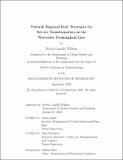Towards Regional Rail: Strategies for Service Transformation on the Worcester/Framingham Line
Author(s)
Wilkins, Devin Camille
DownloadThesis PDF (10.07Mb)
Advisor
Aloisi, James
Attanucci, John
Terms of use
Metadata
Show full item recordAbstract
Increasingly, the urgent threat of climate change has brought renewed focus to the efficiency of cities’ transportation networks and the benefits of mode shift away from the private automobile and towards transit. Over the last three years, changes in journey patterns resulting from the social impacts of the COVID-19 pandemic have triggered questions about the future of public transit systems, and whether changes to established service delivery strategies and fare products are needed. In many ways, commuter rail as a service delivery strategy feels like a relic of a past time, as miles of track and a fleet of train sets sit virtually idle for most of the day until peak weekday commute hours.
The goal of this research is to explore the potential transformation of the Massachusetts Bay Transportation Authority (MBTA) Commuter Rail system into a so-called "regional rail" system. That is, a vast network of heavy rail that leverages its abundant track infrastructure to run high-frequency bi-directional service all day between major population centers in the region. The aim of regional rail service is to serve all members of society equally, not just white-collar commuters.
The Worcester/Framingham line is used as a case study, which runs from Boston’s South Station through 44 miles of the Metro West corridor. Three post-pandemic demand scenarios are proposed and service simulation and schedule optimization tools are developed to generate 3 service plans and policy recommendations that promote increased passenger demand in the near future. This analysis culminates in the proposal of a four-part investment plan for infrastructure and service on the line, culminating in a high-frequency service that serves riders only within the urban core, acting as a "second subway" to augment Boston’s urban rail network.
Date issued
2023-09Department
Massachusetts Institute of Technology. Department of Urban Studies and PlanningPublisher
Massachusetts Institute of Technology